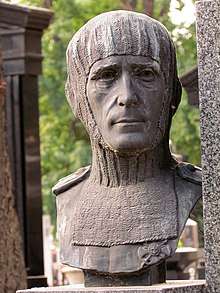Milan Pribićević
Milan Pribićević (Serbian Cyrillic: Милан Прибићевић) was a Yugoslav who nominally led ORJUNA.[1][2]
Milan Pribićević | |
|---|---|
 Milan Pribićević by Malvina Hoffman | |
| Born | 1876 Brod na Savi, Austria-Hungary |
| Died | 8th March 1937 Montreux, Switzerland |
| Allegiance | |
| Rank | Colonel |
| Awards | Order of Karađorđe's Star |
| Spouse(s) | Ruža Pribićević |
Early life
Milan Pribićević was born in Kostajnica in 1877. He came from a well-known Serbian family of politicians in Croatia. He had three brothers, Svetozar Pribićević, Adam Pribićević and Valerijan, all of them were writers and politically involved in everyday affairs, and so was Milan, an Austrian officer who defected to Serbia in 1904. When the Balkan wars broke out, Milan was the first to enlist.
World War I
On the eve of World War I, Milan Pribićević, a highly decorated veteran of the Balkan wars and one of the founders of Narodna Odbrana, began preparing his association which had as an object the formation and equipment of bodies of volunteers for the coming war against Austria-Hungary.
There was no serious attempt to recruit volunteers in the United States until the arrival of the Serbian military mission headed by Colonel Milan Pribićević in November 1916. One of the reasons for this lay in the neutrality of America in the war until near the end of 1917 when it too joined the Allies. Milan Pribićević visited the United States that winter of 1916-1917 to recruit as many volunteers among the U.S. newcomers for the cause as he could. He was joined by Helen Draper, a board member of the New York chapter of the American Red Cross and her sister sculptor Malvina Hoffman, who was involved in war causes, as secretary of the American-Sebian Relief Society in World War I and with the Red Cross.
During Milan Pribićević's military mission, Hoffman modelled two portraits of him, the first smaller but represented him in military uniform, "A Modern Crusader", which followed, shows him lifesize, also in uniform, with epaulets and an ensign on his chest and with a knitted helmet covering his head and framing his strong features. While the head covering looks like chain mail such as was worn by crusaders in the Middle Ages, it is actually a woolen type worn by Serbian soldiers during the cold winters they had to endure from 1912 until 1918.
In 1919 Hoffman travelled to the newly created Yugoslav state on behalf of the American Relief Commission to report on the distribution of American supplies to relief victims. Milan Pribićević had the honour of extending her the same curtesy he received from the members of the American Red Cross in general and Helen Draper and her sister Malvina Hoffman in particular.
Between the Wars
Milan Pribićević, like his brothers, had an uphill fight in politics. At one point, Milan was accused of promoting secession of Lika and Banija from Croatia and seeking their unification with Serbia, but all this was sheer speculation and suspicion meant to undermine Serb-Croat dialogue and compromise during the 1930s.
Pribićević died in 1937.
Legacy
Casts of "A Modern Crusader" are at the New York's American Sculpture Collection in the Metropolitan Museum of Art, the Smithsonian Art Museum, Washington D.C., and the Art Institute of Chicago.
References
- Ivo Banac. The national question in Yugoslavia: origins, history, politics. Paperback edition. Ithaca, New York, USA: Cornell University Press, 1988. Pp. 187.
- Cyprian Blamires. World fascism: a historical encyclopedia, Volume 1. Santa Barbara, California, USA: ABC-CLIO, Inc., 2006. Pp. 745.
- "A Modern Crusader", American Sculpture at the Metropolitan Museum of Art, Vol.2, page 738: https://books.google.com/books?id=slQEFSrX3ooC&pg=PA738&dq=milan+pribicevic&hl=en&sa=X&ei=Au5JUYnHCseSyQGzxIHoBQ&ved=0CF4Q6AEwCA#v=onepage&q=milan%20pribicevic&f=false